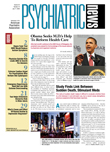With the appearance of President Obama before the AMA House of Delegates and delegates' staging a lengthy debate about the relative merits of a“ public option” for health insurance, the shape of a reformed U.S. health system was front and center at this year's AMA Annual Meeting in June.
It was with virtually unanimous agreement and little debate that AMA delegates also asserted the importance of including parity for mental illness and substance abuse in any health reform plan. The resolution, brought by the Section Council on Psychiatry, asserted in part that “psychiatric care should be... an intrinsic part of medical care” and that “the principles underlying mental health parity are part and parcel of what needs to happen in any broad-scale health reform aiming at universal access, quality improvement, and cost control.”
Despite the passage last year of the Paul Wellstone and Pete Domenici Mental Health Parity and Addiction Equity Act, parity for mental illness and substance abuse under a newly reformed health system is not assured. For one thing, the parity law is not applicable to individual or small-group markets.
Additionally, a new plan could override the law by allowing—for instance—low-cost plans that provide less robust coverage. Just days after the AMA meeting, APA sent a letter to the Senate Health, Education, Labor, and Pensions (HELP) Committee, asking the committee to close loopholes in health reform legislation currently under consideration that could undermine parity. The HELP committee reform law offers exemptions from parity for insurance purchased through the health insurance “exchanges” envisioned in the law; APA's letter asked that the parity law effectively be extended to all insurance, citing the potential incentive for employers who must comply with the parity law to drop insurance coverage and push employees into the exchange market, where their employees would lose parity protections.
At the AMA meeting, Donna Woodson, M.D., a Maumee, Ohio, family physician, said she regularly treats patients with serious mental illness who should be seen by a psychiatrist but can't because their insurance does not adequately cover the treatment.
“The winds of change are upon us,” she said, noting that the AMA had asserted its support for parity coverage in previous policy statements. “This resolution speaks specifically to inclusion of parity in broad-scale health reform. This will assist our psychiatric colleagues, but it really addresses what should be appropriate care for our patients.”
It was not the only section council resolution pertinent to the debate around health system reform. Much of that debate focuses on the costs of American health care, routinely said to be well in excess of other countries' and to yield a poor return on the dollar in terms of health outcomes.
But AMA delegates expressed strong support for a resolution by the Section Council on Psychiatry asking the AMA to reexamine those assumptions.
It calls on the AMA to “undertake a careful examination of the reported cost estimates of the health care systems of comparable developed countries, clarify the services and attendant expenses which are included in such estimates, publicize any estimates which ignore costs shifted to other parts of national budgets, and use this information” in debates about health system reform.
Section council member Ken Certa, M.D., of Phildelphia, said the resolution derived from conversations with physicians in other countries about how certain health care services and costs were budgeted.
In many countries, he said, nursing-home services are under a social-service budget, not a health care one. “But when we go to Harrisburg [state capital of Pennsylvania] to lobby for health care programs, they tell us half of the Medicaid budget is going to our nursing home care,” Certa said.
“Another discrepancy is that in other countries medical education is essentially free” for students, he said. He cited a colleague whose tuition from a Central American medical school was $10 a year, while American students graduate with an average debt of $160,000.
That debt must be paid back out of physicians' earnings, making it one of the drivers behind physician reimbursement rates. Moreover, graduate medical education costs are largely borne by Medicare and some state systems; meanwhile, medical graduates from all over the world vie to receive training in the American system. ▪
